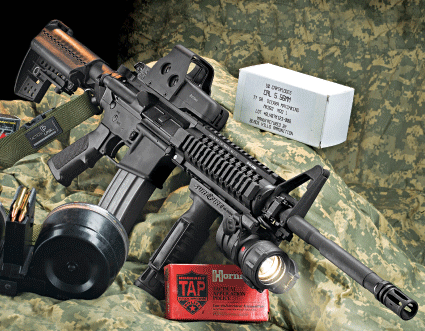Currently black rifles, as they are popularly known, are a hot ticket in the firearms industry. It seems manufacturers can’t build them fast enough to meet demand and there is good reason. The basic AR platform is one of the most flexible firearms in history. By changing upper receivers, one can go from the basic .223 caliber to any cartridge that will fit into the AR’s performance envelope. As long as a magazine can be inserted into the magazine well, caliber changes take only a few seconds.
As this is written in late spring 2008, conversion upper receivers are available in calibers ranging from .22LR to the butt-kicking .50 Beowulf. The fact that the M16 family is the longest serving small arm in American military history has also had a positive influence on the rifle’s popularity. With the US Army standardizing on the M4 and M4A1 carbines, and SWAT units turning in their submachine guns (SMG) in favor of AR-15-type carbines, the collapsible stock carbine has grown in popularity as well.
By adding a handguard with MIL-STD-1913 rails, the basic carbine is transformed into a modular weapon capable of accepting all the accessories that characterize modern law enforcement tactical operations. For police patrol, semi-automatic AR carbines are likewise the order of the day and most officers opt for an AR when they purchase a carbine of their own for duty or personal use. Many police departments that arm their officers with rifle caliber carbines also choose an AR-type carbine for patrol carry.
Advertisement — Continue Reading Below
It is safe to say that the AR-type carbine is replacing the shotgun as the law enforcement long gun of choice. The same is true for civilians desiring a 5.56mm NATO carbine for self-defense or sporting use. The AR dominates every market.
One of the premier manufacturers of AR-type rifles and carbines is Stag Arms. Although they are a relative newcomer to the commercial AR market, the company is a long-time supplier of AR components to major commercial manufacturers. Stag Arms manufactures a full line of ARs in both 5.56mm NATO and 6.8mm SPC. Prior to entering the commercial rifle business, Stag Arms was one of the few companies that manufactured components for firms that assembled their ARs from parts. Therefore they are one of the handful of companies that make every major component of their rifles in-house, so that Stag Arms ARs can be offered at reasonable prices with no compromise in quality.
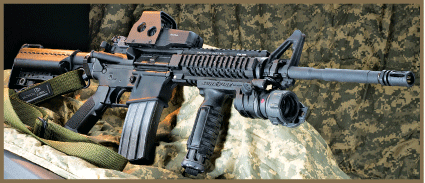
Advertisement — Continue Reading Below
Gun Details
Every Stag Arms test sample we have been provided displays quality throughout. Their ARs are among the best in overall fit, finish and quality of assembly. Upper and lower receivers are both forged from 7075-T6 aluminum. There is virtually no play whatsoever between the upper and lower receivers, and both are uniformly black anodized and Teflon-coated per military specification.
Finally, every Stag Arms AR is available in a left-hand version. Everything from ejection port to all controls is set up for left-handed shooters. For southpaws, there aren’t many other choices.
But a rifle doesn’t end with external fit and finish, although that is a good starting point. The hammer and fire control components have been polished and there is some hand fitting. Another feature that we like is that the hammer is cocked by the bolt carrier and not with the firing pin as with some other ARs.
Advertisement — Continue Reading Below
Having the firing pin cock the hammer is an additional, but unnecessary, impediment to illegally converting a semi-auto rifle to full automatic. M16 bolt carriers are commonly available, so using the firing pin to cock the hammer is a meaningless gesture. While the firing pin will take the stress, there is no reason to subject it to more in the name of political correctness when the bolt carrier is much more robust.
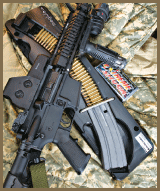 The Stag Arms semi-auto bolt carrier will not trip the auto sear on a full-auto lower. That requires a modification to the rear of the bolt carrier, not the front, which is modified to use the firing pin to cock the hammer.
The Stag Arms semi-auto bolt carrier will not trip the auto sear on a full-auto lower. That requires a modification to the rear of the bolt carrier, not the front, which is modified to use the firing pin to cock the hammer.
The Stag-15 Model 2T has a chrome-lined barrel with 1-in-9-inch twist rate. The chamber is cut to 5.56x45mm specification. This is important because .223 chamber dimensions are different from Mil-Spec and using military ammunition in .223 chambers could result in dangerous overpressures. The collapsible stock is the latest 6-position type for different thickness clothing or body armor uses. We replaced the standard stock with a newer aftermarket stock.
Advertisement — Continue Reading Below
The Stag-15 Model 2T came with a Samson STAR-C Tactical Accessory Rail System that can be installed without removing the front sight, if the user decides to add this accessory to an existing carbine. The STAR-C also free floats the barrel, a critical element when using heavy accessories and full-auto fire, although this is less critical in semi-auto action. Why is a free-floating barrel so critical when using the many accessories that are common in today’s tactical operations and in full-auto action?
A real world example is Special Operations Forces when they must break contact or overcome an ambush. To do so, a heavy volume of full-auto fire is mandatory. This causes barrels to reach red-hot temperatures in short order, especially in carbines with short 6-inch gas tubes. If the barrel isn’t fully free floated, heavy pressure on the vertical foregrip can cause the hot barrel to bend slightly in the center with the result that bullets come out the side of the barrel rather than out the muzzle.
As unlikely as this may sound, it is a documented fact, so a free-floating tube does more than just enhance accuracy. In semi-auto guns, the free-floating barrel also ensures that accessories such as vertical foregrips do not affect zero or point-of-aim. The Samson tube is made of 6061-T6 aircraft aluminum, hard coat anodized to Mil-Spec, has a removable bottom rail to accommodate an M203 grenade launcher, a winged clamp to eliminate barrel nut rotation and forms a continuous top rail in conjunction with the carbine’s flat top upper receiver. It is also ventilated to dissipate heat.
Advertisement — Continue Reading Below
![]() Trijicon TANS
Trijicon TANS
Trijicon’s Gen III+ Tactical Advanced NightVision System (TANS) is designed for short-barreled carbines like the Stag-15 Model 2T. Manufactured for Trijicon by Optical Systems Technology, the TANS is built to full Mil-Spec. Images seen through the TANS in darkness are clear. Unlike earlier night vision devices (NVD), the TANS mounts forward of the day optic on the STAR-C MIL-STD-1913 rail via a LaRue throw lever, so eye relief is not an issue.
The tube is a true ITT (image intensifier tube) “WG” (weapons grade) intensifier, and the LaRue mount incorporates a special suspension system that helps protect the optic when mounted on other weapons that produce heavy recoil.
TANS can be used with the weapon’s day optics without any adapters, so an illuminated reticle, IR (infrared) or otherwise is not needed. The TANS can also be used as a handheld night vision optic. It also has no affect on the day optic’s reticle or the rifle’s zero. Furthermore, the TANS incorporates autogating technology that automatically regulates the amount of light entering the intensifier tube, preventing blooming caused by bright lights and muzzle flashes.
Advertisement — Continue Reading Below
Finally, the TANS intensifier tube is assembled in the optic so that it is shock mitigated, so it is resistant to shock. Just because a NVD has a Gen 3 or Gen 3+ tube doesn’t mean that it has autogating and shock mitigation.
It will identify a man-size target at nearly 900 meters with no ambient light other than starlight. With a quarter moon, these targets can be picked up out to 1070 meters. Using starlight, the TANS can be used for facial recognition at 65 meters and with a quarter moon out to 105 meters. With the addition of an IR light source, the carbine with TANS mounted can be used to clear without visible light.
Insight CNVD-T
When conditions arise where image intensifiers optics cannot function, thermal imagers can usually save the day (or night) because they incorporate an entirely different technology. Where image intensifiers amplify available light, thermal imagers do not need any light whatsoever to function because they work by detecting the differences in IR radiation that is emitted by just about everything. Because almost everything emits some levels of IR that increases or decreases based on its temperature, thermal imagers detect variations in the levels of IR and display them through the device’s objective lens. Thermal imagers can also “see” through smoke and fog. While this is an overly simplistic explanation of how thermal imagers function, it captures the essence of their operation at a sufficient level for this evaluation.
Advertisement — Continue Reading Below
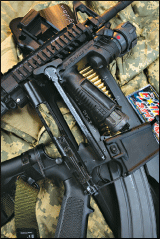 The latest military and law enforcement thermal imagers can be mounted ahead of a weapon’s day optic, just like the TANS, so no adapters are necessary. The current state of the art in these devices is Insight Tech-Gear’s CNVD-T thermal sight, which has been adopted by the US Army with the designation Individual Weapon Night Sight – Thermal (IWNS-T). The IWNS-T can also be used as a hand-held night vision optic.
The latest military and law enforcement thermal imagers can be mounted ahead of a weapon’s day optic, just like the TANS, so no adapters are necessary. The current state of the art in these devices is Insight Tech-Gear’s CNVD-T thermal sight, which has been adopted by the US Army with the designation Individual Weapon Night Sight – Thermal (IWNS-T). The IWNS-T can also be used as a hand-held night vision optic.
SureFire M900A
SureFire’s M900A Vertical Foregrip WeaponLight is another widely used accessory because not only does it provide a vertical foregrip with a source of high-intensity white light, but has an IR capability as well. The M900A has two side-mounted pressure switches on the foregrip for the main beam; a constant-on switch, a system disable switch and finally, a small switch to operate the low-level LED (light emitting diode) navigation lights to limit the amount of light.
The M900 uses three EL123 lithium batteries and has a 60-minute runtime at the standard 125 lumens output. When the optional 225 lumens lamp is installed, runtime drops to 20 minutes. Even at the lower 125 lumens output, the M900A is still bright enough to momentarily flash-blind individuals.
Advertisement — Continue Reading Below
The M900A can be converted to IR operation for use with night vision optics like the TANS by attaching the FM13 IR filter. The IR filter blocks the non-IR portion of the spectrum and allows only the IR light to pass. IR is invisible to the naked eye, but can be seen through night vision optics and, although night vision optics allow the user to see in the dark, the high-intensity IR light of the M900A acts like an invisible searchlight to illuminate areas that might be invisible even through NVD optics. The filter attaches to the lamp head via a camlock mechanism and the filter lens locks into place over the lamp using a spring-loaded latch.
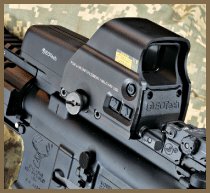 L-3 EOTech HWS
L-3 EOTech HWS
Optics are becoming commonplace in tactical operations because they are generally faster to use and more accurate than traditional iron sights. One of the most widely used optical sights is the L-3 EOTech Holographic Weapon Sight (HWS). The HWS is fully night vision compatible with an IR reticle, although with the TANS, the IR reticle isn’t necessary. Some users do not use the reticle at CQB (close quarter battle) distances, but simply frame the target in the center of the HWS hardened glass window and shoot. All the shooter needs to do is keep both eyes open, look at the target and shoulder their weapon. Sight alignment is instinctive and instantaneous.
Chip McCormick Drop-In Trigger
Although the factory trigger was acceptable, we couldn’t resist the urge to improve it and ordered a Chip McCormick modular drop-in trigger. The Chip McCormick trigger is easier to install than typical upgrades because it comes as a unitary module that drops into the carbine’s receiver after the factory trigger components have been removed. The Chip McCormick modular trigger has no adjustments and breaks at a crisp 3.5 pounds.
Shooting Impressions
With our Stag Arms 2T equipped as it might well be for law enforcement or military tactical operations, we headed to the range. As has been the case with all Stag Arms rifles, our test 2T functioned with total reliability and good accuracy. Handling was typical AR with all controls in easy reach without changing one’s grip on the carbine. The Modstock made for improved cheek weld and better eye relief with the L-3 EOTech HWS and just slid into place on the drive spring tube after removing the original M4-type collapsible stock. The L-3 EOTech HWS simplified and sped target acquisition. The Chip McCormick drop-in trigger broke like the proverbial “glass rod” at 3.5 pounds, likewise enhanced overall performance and target engagement. Even in its basic configuration, our Stag Arms 2T represents an excellent carbine for any police department, individual officer or civilian seeking a high quality, reasonably priced, reliable and accurate AR-type carbine that comes ready to set up for 24/7 tactical operations right from the box.
Even in its basic configuration, our Stag-15 Model 2T represents an excellent carbine for any police department, individual officer or civilian seeking a high quality, reasonably priced, reliable and accurate AR-type carbine that comes ready to set up for 24/7 tactical operations right from the box.
